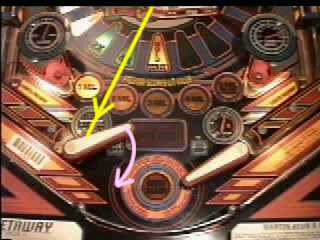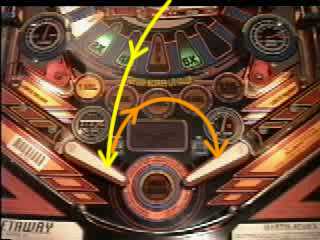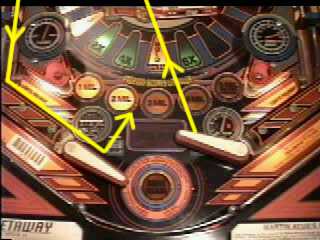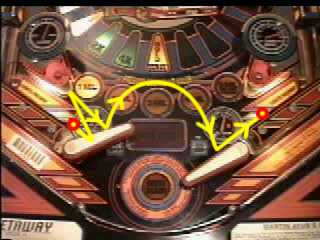|
|
|
SKILL
SHOTS
|
|
If you want to play better pinball you need to keep control of the ball for as much of the game as possible. That way you can aim for each shot rather than use a hit-and-hope approach. If your shot misses, you can get the ball back and try again. The ball is in your control, not the game's. That's the theory anyway. In this article we'll look at how you stop the ball and make sure it's on the correct flipper for the next shot. We'll explain the technical terms and there are some movie files so you can see the theory in practice. Before we kick off, it's important to remember a few basic rules. Firstly, every pinball game is different. The slope, speed, strength of flippers, sensitivity of slingshots, everything is infinitely variable so it's important that you learn the 'feel' of a game before you rely on these techniques. Most of all, play in a way you feel comfortable with. Secondly, playing good pinball is a skill. It can be learned but it requires practice. Lots of practice, and that can make it hard work. Now, we all play pinball for fun so why make it hard work? Because with these skills you'll score more points, get further into the game and become a total hero while wowing your friends into buying you free drinks all night. Well, perhaps not the last bit but you get the idea. Finally, the point
of these techniques is to stop the ball getting into trouble. The path
of the ball is all about cause and effect. You flipping the ball results
in it taking a particular path. Get it right and the ball is safe. Get
it wrong and you're into a damage limitation exercise. If we can start
with a stopped ball on the correct flipper with all the time we need
to line up the shot, the chances of making the shot improve enormously
over making a reflex panic shot. OK, enough explanation of what we're going to do. Let's get on with it. Each of these techniques
is shown on a Williams High Speed 2 - The Getaway. There are images
showing the path of the ball and movie files showing the technique in
action. Trapping the ball This is the bread-and-butter of pinball ball control and if you've played more that a few games you'll have used this already.
Catching the ball Catching is similar to Trapping in that you stop the ball, but in Catching you only have the ball stationary for a brief moment and then have to make an almost immediate shot. The Drop Catch - This is moderately difficult manoeuvre with a medium risk attached. When the ball is headed straight towards a flipper and you want to shoot from that flipper, use the drop catch to stop the ball and set yourself up for the next shot. The key to this 2-part technique is all in the timing.
Once you've mastered the timing, the main danger with this shot come from a ball with lots of spin on it. As the ball lands on the falling flipper, although it stops travelling down the playfield, the spin on the ball can send it either up the flipper into the inlane (counterclockwise spin), or worse, straight down the centre drain (clockwise spin). The spin directions are reversed on the right-hand flipper. Because the ball is hard against the flipper rubber when it stops, any spin has a perfect grip on the rubber so you often don't get a chance to spot it until it's too late. The other potential problem is if you misjudge where the ball will land, and it actually hits the metal strip just above the flipper at the bottom of the inlane. In this case the ball fails to stop and just runs straight down the middle. In both cases you
end up looking very silly, so beware.
Passing the ball Catching and trapping
are fine if your next shot is from the same flipper as the one with
the ball. But what about if you have the ball on the wrong flipper?
That's where you use a passing technique.
First, this technique works best when the ball come in perpendicular to the flipper face. If the ball is rolling down the slingshot face, it will probably bounce straight into the centre drain. Secondly, the ball needs to have a decent speed. Obviously, how far it bounces depends on how fast it's travelling. Make sure it's moving fast enough to bounce over to the other flipper. Thirdly, this method is as vulnerable to ball spin as the drop catch and the results are the same. Don't assume that just because the bounce should work, that it will. Watch it happen, and be prepared for the ball not to end up quite where it should. Finally, don't try this if the flippers are sticky, especially if they don't drop down fully. In this case the ball just knocks the flipper right down and promptly drains in a kind of failed-drop-catch manoeuvre. With all these provisos, the skill to using the Bounce Pass is knowing when you can use it and when to use another method.
There is a potential disadvantage to the shot pass. By making the shot you may collect an award or feature that you'd rather leave uncollected. Also the shot may be sufficiently difficult to not be worth the risk. The advantage is the flip-side to this. You make the pass and collect whatever award is associated with the shot.
By varying the duration and timing of the mini-flip you can control the strength of the Post Pass. The stronger the pass, the further up the opposite flipper the ball lands. To catch the ball on the opposite flipper, you need a powerful pass so that the ball bounces across and lands on the inlane guide, killing its power. Mini-flip too hard and the ball will bounce across onto the slingshot ruining your pass. If you mini-flip too softly or too early, the ball will either just rattle around the 'V' between the raised flipper and the inlane guide, or it won't get enough momentum to bounce over to the other flipper. In this case the ball can gently roll off the end of the raised flipper and down the centre drain. If this happens, it seems to happen in slow-motion. It's transfixing. It's also very funny for anyone else watching. Make sure you're happy that the ball is travelling fast enough to get across that gap, otherwise you can make another very gentle flip to help it on it's way, or a full-blooded flip to make a shot. If you leave the mini-flip too late, you'll just make a regular shot.
So that's about it for now. We'll be back soon with the next installment of skills to learn, including deathsaves.
© Pinball News 2002 |





